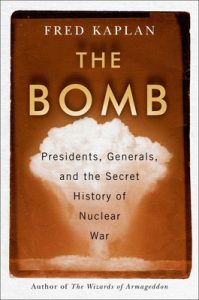
How We Learned to Start Fearing the Bomb, Again
Fred Kaplan on the Nuclear First-Strike Dilemma
When Jim Mattis went up on Capitol Hill to request funding for the low-yield Trident II, he was met with apprehension. Not because of the cost—the price tag for modifying a few dozen warheads was $65 million, a pittance in a defense budget exceeding $700 billion. Nor were many lawmakers concerned about this new weapon per se. Rather, they were concerned about the man who had the power to launch it.
Arms control advocates had long argued that low-yield nuclear weapons were destabilizing because they lowered the threshold between conventional and nuclear war. They seemed to be—they were designed to be—more usable as weapons of war, and, therefore, some president, in a crisis, might feel more tempted to use them. The human factor was key: some presidents might resist the temptation; others might risk all.
Donald Trump wasn’t the first president who inspired mistrust on this score. In 2003, after the invasion of Iraq, some Air Force generals proposed building a new low-yield nuclear warhead that burrowed underground before exploding, seeing it as an ideal weapon for killing some future Saddam Hussein in his bunker.
But many on the House and Senate Armed Services Committees did not trust President George W. Bush with such a weapon, so they tacked on an amendment to that year’s defense budget, prohibiting the “testing, acquisition, or deployment of a low-yield nuclear weapon”—and barring the Department of Energy from even conducting research or development for such a weapon—without the advance approval of Congress.
Now, 15 years later, Mattis was running into similar problems with Trump. It wasn’t the first time he’d heard this concern.
On October 30th, two and a half months after Trump’s “fire and fury” fusillade at North Korea, Senator Edward Markey—a Massachusetts Democrat, the fourth-longest-serving member of Congress (mainly in the House), and a firm advocate of nuclear arms reduction—sat on the dais of the Foreign Relations Committee, listening to Mattis and Rex Tillerson testify at a hearing on whether the president needed new congressional authorization to use military force against terrorists around the world.
When his turn came to ask questions, Markey expanded the inquiry. Could Trump launch a nuclear first strike, he asked, without consulting any members of Congress?
Arms control advocates had long argued that low-yield nuclear weapons were destabilizing because they lowered the threshold between conventional and nuclear war.
Mattis hesitated, called the question “hypothetical,” and noted that the process for launching nuclear weapons was “extremely rigorous.” When Markey repeated the question, Mattis allowed that he could imagine the president ordering a first strike if an adversary was seen “preparing” to launch an attack and if the threat was “imminent.” Tillerson added that no president had forsworn first use as an option and that the policy had “served us for 70 years.”
None of this was news to Markey. He was long aware of the president’s exclusive power to destroy the planet. At the start of Trump’s term, he had drafted a bill to prohibit a nuclear first strike without congressional consent. But few of Markey’s colleagues, even those on the Senate Foreign Relations Committee, knew just how unchecked the president’s powers on this front were.
Among those senators was Bob Corker, the committee’s Republican chairman. Corker, a businessman from Tennessee, was deeply conservative, but he was also agitated by stories he’d been hearing about Trump’s mental state. Recently Corker had made a stir by tweeting that the White House was like an “adult day care center” and telling a reporter that Trump’s reckless threats toward other countries were paving a “path to World War III.”
After the hearing, with the Mattis-Markey exchange in mind, Corker told his staff that he was “riled up” by the issue of nuclear command-control and wanted to hold a separate hearing on the subject as soon as possible—“something real sober,” as he put it, “pointing out that the President has the power to basically destroy the world.”
The hearing was held just two weeks later, on November 14th. In the interim, the Congressional Research Service prepared a memo, noting, among other facts, that it would be the first hearing on the subject in 41 years.
In his opening statement, the committee’s ranking Democrat, Benjamin Cardin of Maryland, said that he didn’t usually get questions about foreign policy at town hall meetings, but ever since Trump’s warning to North Korea, a lot of constituents had been asking, “Can the President really order a nuclear attack without any controls?”
The committee staff had assembled three witnesses—one retired four-star general, one Democrat, and one Republican. The first to testify was the general—Robert Kehler, the former StratCom commander who had guided President Obama’s security team through the SIOP and, just before Trump’s inauguration, had signed the letter to the Wall Street Journal calling for the retention of the Triad.
Kehler’s main point was that the president did not have a completely free hand. “The United States military does not blindly follow orders,” Kehler said. “A presidential order to employ U.S. nuclear weapons must be legal. The basic legal principles of military necessity, distinction, and proportionality apply to nuclear weapons, just as they do to every other weapon.”
Cardin asked who would decide whether the order was illegal. “Well,” Kehler replied, “that is one of the things that would be on the plate of the commander of Strategic Command.”
“So,” Cardin said, “let me just drill down on this.” If Kehler were still head of StratCom, and if the president ordered a first strike that did not meet the legal test of proportionality, could he decide “to disobey the Commander in Chief?”
“Yes,” Kehler replied. “If there is an illegal order presented to the military, the military is obligated to refuse to follow it.”
Some of the senators and their staff raised their eyebrows a few notches. Ordinarily, someone in Kehler’s position would avoid answering such a question, pleading—as Mattis had, when Markey posed a similar question—that it was “hypothetical.”
But upon further questioning, Kehler’s bold assurance turned wobbly. Republican senator Ron Johnson of Wisconsin asked him how he would have gone about refusing to follow an illegal order.
Kehler replied, “I would have said, ‘I have a question about this,’ and I would have said, ‘I’m not ready to proceed.’ ”
“And then what happens?” Johnson asked.
If the members of Congress thought the president was unfit to command, then they needed to take responsibility and change the procedures.
“Well,” Kehler said. He paused, and nervous laughter flitted through the chamber. “As I say,” he went on, with a slight grin, “I don’t know exactly. Fortunately, we’ve never—these are all hypothetical scenarios. I mean, they’re real, in terms of—”
Johnson interrupted, “We are holding a hearing on this, so—”
“Exactly,” Kehler replied. “This is the human factor in our system. The human factor kicks in.”
And that opened the door to the question of what happens to all the legal principles when the human is Donald Trump.
Senator Chris Murphy, Democrat of Connecticut, raised the point in the starkest terms. “Let me just pull back the cover for a minute from this hearing,” he began. “We are concerned that the President of the United States is so unstable, is so volatile, has a decision-making process that is so quixotic, that he might order a nuclear-weapons strike that is wildly out of step with U.S. national security interests. Let’s just recognize the exceptional nature of this moment in the discussion that we are having today.”
Murphy then asked the Republican witness, Peter Feaver, who had worked as a special adviser to President George W. Bush, whether an enemy power’s mere possession of a nuclear weapon, with the range to reach the United States, would constitute an “imminent attack” and thus put the president on solid legal ground in ordering a first strike.
Feaver, while noting that he wasn’t a lawyer, replied that it probably did pass the legal test. “I think it would, in most people’s minds, constitute a grave threat to U.S. national security, particularly if it was a North Korean nuclear warhead atop a North Korean missile that was capable of reaching the United States,” he elaborated.
Brian McKeon, the Democratic witness, who had worked in the NSC and the Pentagon under President Obama, disagreed. “Senator,” he said, “the mere possession of a nuclear weapon, I do not think would meet that test.” The North Koreans “have a nuclear weapon today, we know that much.” If the president considered it sufficiently threatening to warrant a first strike, there would be plenty of time to seek congressional authorization.
As the hearing went on, it became clear that the debate was ultimately beside the point. Kehler noted that “nuclear decision-making at the highest level” is “a consultative process,” involving many people— the head of StratCom, the secretary of defense, and other advisers—any one of whom could say, as he put it, “Wait, stop, we need to resolve these issues.”
But, he also acknowledged, if the president wanted to launch one of the many pre-set attack options that were listed in the nuclear war plan, the fact that the option was in the plan meant that the military lawyers had already vetted it. Ultimately, he acknowledged, the “decision authority”—the legal power to launch nuclear weapons—“resides with the President.”
Senator Markey, who had prompted the hearing, then made what he considered the central point:
Absent a nuclear attack upon the United States or our allies, no one human being should have the power to unilaterally unleash the most destructive forces ever devised by humankind. Yet, under existing law, the President of the United States can start a nuclear war without provocation, without consultation, and without warning. It boggles the rational mind. I fear that, in the age of Trump, the cooler heads and strategic doctrine that we once relied upon as our last best hope against the unthinkable seem less reassuring than ever.
The hearing came to a close after a few hours—by contrast, the 1976 hearing on the same subject had lasted four days—with no consequences. Markey’s legislation had no more chance of passing than similar bills put forth in the past. (In 1972, Senator William Fulbright proposed an amendment to the War Powers Act, prohibiting the president from launching a nuclear first strike without congressional approval. It was voted down, 10 to 68.)
Few in Congress had ever wanted the responsibility of making weighty decisions on war and peace. Few Republicans at this hearing even took much interest in exploring the dilemmas. Most of them used their time not to ask probing questions but to warn against the dangers of letting—as Florida senator Marco Rubio put it—“a bunch of bunker lawyers decide that they are going to disobey any order that they disagree with.”
It was sobering to some senior officers who watched the hearing that not a single senator, not even any of the Republicans, bothered to dispute the claim, openly expressed by some of the Democrats, that President Trump was “unstable” or that his very presence in the Oval Office—his everyday access to the button—made nuclear war more possible.
General Kehler, sitting as a witness, may have been most flustered of all. It was up to Congress to set the rules on the procedures and safeguards for the use of nuclear weapons. If the members of Congress thought the president was unfit to command, then they needed to take responsibility and change the procedures; they couldn’t just toss it in the laps of the military. Worse still would be if they raised provocative questions about the president’s fitness, then did nothing, leaving the generals with a chain of command that no one could trust. Yet, he thought to himself, that is what this committee was doing.
There was a history of senior officials and underlings maneuvering around an untrustworthy chain of command. Back in the summer of 1974, amid reports of President Nixon’s frequent drunkenness under the pressures of Watergate and his imminent impeachment, Secretary of Defense James Schlesinger quietly asked the Joint Chiefs of Staff to call him if they received any “unusual orders” from the commander-in-chief (neither the secretary of defense nor the Chiefs were, then or now, in the chain of command for nuclear orders).
Was Trump, perhaps unwittingly, testing Richard Nixon’s “Madman Theory”?
In late 1973, Major Harold Hering, a Minuteman launch officer in training, asked his instructors, “How can I know that an order I receive to launch my missiles came from a sane President?” And, more broadly: “What checks and balances exist to verify that an unlawful order does not get in to the missile men?” Hering, a proud Air Force officer, had served multiple tours as a helicopter pilot in Vietnam. He simply wanted assurances that, if he ever got the signal to launch nuclear missiles against a foreign country, he would be following legal orders, as military law required. He was instantly yanked out of missile crewman class, given a desk job, and, after a review board hearing, drummed out of the military.
Nobody wanted to answer Hering’s questions, in part because they couldn’t be answered without raising doubts about the whole system of command and control over nuclear weapons. They aroused suspicions that the elaborate process of consultation over the decision to launch nuclear weapons might be fragile. “The human factor kicks in,” as General Kehler testified. There was no safety switch in place, no circuit breaker that someone could throw, if the human turned out to be crazy.
*
Donald Trump wound up not going to war with North Korea after all. Instead, on New Year’s Day 2018, Kim Jong-un launched a peace offensive, offering to send a delegation to the upcoming Winter Olympics in Seoul and calling for warmer relations with South Korea, including “bilateral contact, travel, cooperation and exchange on a broad scale.” South Korean president Moon Jae-in, eager for détente, embraced the offer, forming a joint North-South team at the Olympics and scheduling a summit in which both leaders would cross the Demilitarized Zone together.
On April 20th, six days before this summit, Kim announced that he would cease testing nuclear weapons or medium- to long-range missiles. On June 12th, Kim and Trump held their own summit, in Singapore—the first time a North Korean leader and a sitting American president had ever met face-to-face.
How did this happen? Did Trump’s campaign of “maximum pressure” work? Did his intensification of sanctions, his threat of raining “fire and fury” on North Korea, and the ATACM “demonstration attacks” frighten Kim to the bargaining table? Was Trump, perhaps unwittingly, testing Richard Nixon’s “Madman Theory”? Nixon had told Henry Kissinger to warn the North Vietnamese that he was crazy and might use nuclear weapons if they didn’t end the war. The ploy failed, possibly because the North Vietnamese didn’t believe Nixon was mad in quite that way.
Did Kim fear that Trump might really be a madman? President Moon certainly feared he might be. American officials put out the word—this time without pretending—that Trump was erratic, unpredictable, different from previous presidents, though all this was clear without these messages. This was what led Moon to accept Kim’s overtures at once, to schedule a summit, to urge Kim to ask for a separate meeting with Trump, and to urge Trump to accept the invitation.
Kim too may have been shaken by the strange American president’s pressure; no previous administration had fired missiles in response to a North Korean action. But the chronology called this theory into question. Trump issued his “fire and fury” warning on August 8th. Three weeks later, on August 28th, Kim test-fired an intermediate-range ballistic missile over Japan. On September 3rd, he detonated a nuclear device at a test site for the sixth time, this one the most powerful explosion to date, so powerful that he declared it to be—and several Western analysts concluded that it probably was—a hydrogen bomb.
On September 14th, he test-launched another intermediate-range missile. Finally, on November 28th, he fired a missile having the range to strike U.S. territory. In other words, after Trump’s most bellicose remarks, Kim conducted four tests honing his ability to strike America and its allies. Far from appearing intimidated by Trump’s threats, Kim seemed to be moving steadily along his path to acquiring a nuclear arsenal.
In his New Year’s Day address, Kim said he could now move for peace because, in the past year, he had satisfied the “great historic cause of perfecting the national nuclear forces” and now possessed “a powerful and reliable war deterrent, which no force and no thing can reverse.” Three months later, he justified his announcement of a test moratorium on the grounds that he had “verified the completion of nuclear weapons” and, therefore, “we no longer need” to keep testing.
Whatever pushed Kim Jong-un to the bargaining table, Trump proved incapable of exploiting any leverage he might have gained.
It may never be known whether Kim pivoted because of Trump’s pressure or because North Korea now had a nuclear deterrent, fulfilling the atomic dreams of his father and grandfather. Both factors may have played a role. Daniel Ellsberg, the nuclear war planner turned antiwar activist, counts 25 instances—before Trump entered office—of American presidents threatening to use nuclear weapons since the end of World War II. Ellsberg deplores these threats as reckless—regards them as synonymous with using nuclear weapons, “in the precise way that a gun is used when you point it at someone’s head in a direct confrontation.”
Yet, even he acknowledges that “several” of these threats may have been effective in deterring war or in damping down a conflict and that, either way, in “most” of these cases, senior U.S. officials believed the threats were effective—meaning that, in future crises, they or their successors might issue similar threats again, though it may be only a matter of time before one of these bluffs is called, with catastrophic consequences.
Whatever pushed Kim to the bargaining table, Trump proved incapable of exploiting any leverage he might have gained. In previous meetings with foreign leaders, especially with autocrats (Russia’s Vladimir Putin, China’s Xi Jinping, Saudi Arabia’s King Salman), Trump had purred and rolled over when they treated him with respect (feigned or real), and Kim pushed those same buttons masterfully. At their June summit in Singapore, Trump gave away more than he got, canceling an upcoming U.S.–South Korea military exercise, while Kim pledged only “to work toward complete denuclearization of the Korean Peninsula,” without setting a timetable or defining “denuclearization.”
Yet on that basis, Trump declared, after the summit, that there was “no longer a nuclear threat from North Korea” and hailed Kim as a “good friend” and “great leader.” For more than a year afterward, he touted his relationship with Chairman Kim. “He wrote me beautiful letters,” Trump gushed at one rally. “We fell in love.”
The rest of the world, including many American officials and experts, gasped in dismay and puzzlement. Months before his summit with Kim, Trump had withdrawn from the Iran nuclear deal, a highly detailed accord that blocked the mullahs of Tehran from every possible path toward acquiring a nuclear weapon, calling it “the worst deal ever,” even though Jim Mattis, after reading the text three times, characterized its verification protocols as “robust” and even though the International Atomic Energy Agency attested, repeatedly, after several inspections, that Iran was abiding by its terms.
Not long after junking that deal, Trump pulled out of the Intermediate-Range Nuclear Forces Treaty, which Ronald Reagan and Mikhail Gorbachev had signed, as a Cold War coda, in 1987. Trump accused the Russians of cheating, as had President Obama. The treaty barred both countries from testing ground-launched missiles having a range of 500 to 5,000 kilometers; the Russians had tested a cruise missile within the prohibited range. But withdrawing from the treaty gave the Russians what they wanted. The Russian military had abhorred the INF Treaty from the moment Gorbachev signed it.
When George W. Bush was president, Russia’s defense minister, Sergei Ivanov, implored Secretary of Defense Donald Rumsfeld three times to make a deal allowing both sides to get out of the treaty. Rumsfeld ignored the request, knowing that there was no appetite, in the U.S. or Western Europe, for bringing back these sorts of missiles. Killing the treaty would help only the Russians, giving them free rein to build as many of these weapons as they liked and to blame the breakdown on the Americans, while doing nothing for the West. Trump was falling in the trap that Rumsfeld had skirted.
New START, the treaty signed by Obama and Dmitry Medvedev, will expire in 2021, and neither Trump nor Putin has taken a single step toward negotiating an extension or a sequel. New START placed limits on Russian and American strategic nuclear weapons—the missiles and bombers aimed at each other’s territory. Both countries have abided by this treaty’s terms; not even implacable foes of arms control have claimed otherwise. It was a modest treaty (“relatively benign,” as Jon Kyl, its leading critic in the Senate, described it).
But if it disappeared, the lid would blow off: generals on both sides could press for more weapons, to satisfy more “requirements” and to fill “gaps” in fanciful scenarios; if East-West relations remained tense, the nuclear arms race, after decades of winding down, could rev up for another brutal round.
Trump was not solely to blame for these tensions or breakdowns. He came to the White House two decades into the post–Cold War disorder, amid a diffusion of global power, the crumbling of power blocs, the shifting of borders, the diminishing authority of institutions. Yet he certainly accelerated these trends, sometimes willfully, ripping up treaties, shrugging off alliances, scrambling the arrangements of the global system that the United States had created and helped lead, to its benefit, since the end of World War II.
He came to the White House believing that the world was a mess because his predecessors didn’t know how to make good deals—and that he would clean things up because making deals was his specialty. In June 2018, shortly before his first summit with Kim Jong-un, Trump met in the White House with Shinzo Abe, Japan’s prime minister. Abe proposed that he and Trump get their respective national security teams to work out a joint negotiating strategy. H. R. McMaster, who’d heard the suggestion ahead of time, was enthusiastic about the idea, as was much of his staff: the two teams had similar views; the two countries had common interests.
__________________________________

From The Bomb: Presidents, Generals, and the Secret History of Nuclear War. Used with the permission of the publisher, Simon & Schuster. Copyright © 2020 by Fred Kaplan.
Fred M. Kaplan
Fred Kaplan is the national-security columnist for Slate and the author of five previous books, Dark Territory: The Secret History of Cyber War, The Insurgents: David Petraeus and the Plot to Change the American Way of War (a Pulitzer Prize finalist and New York Times bestseller), 1959, Daydream Believers, and The Wizards of Armageddon. He lives in Brooklyn with his wife, Brooke Gladstone. The Bomb: Presidents, Generals, and the Secret History of Nuclear War is out now from Simon & Schuster.












